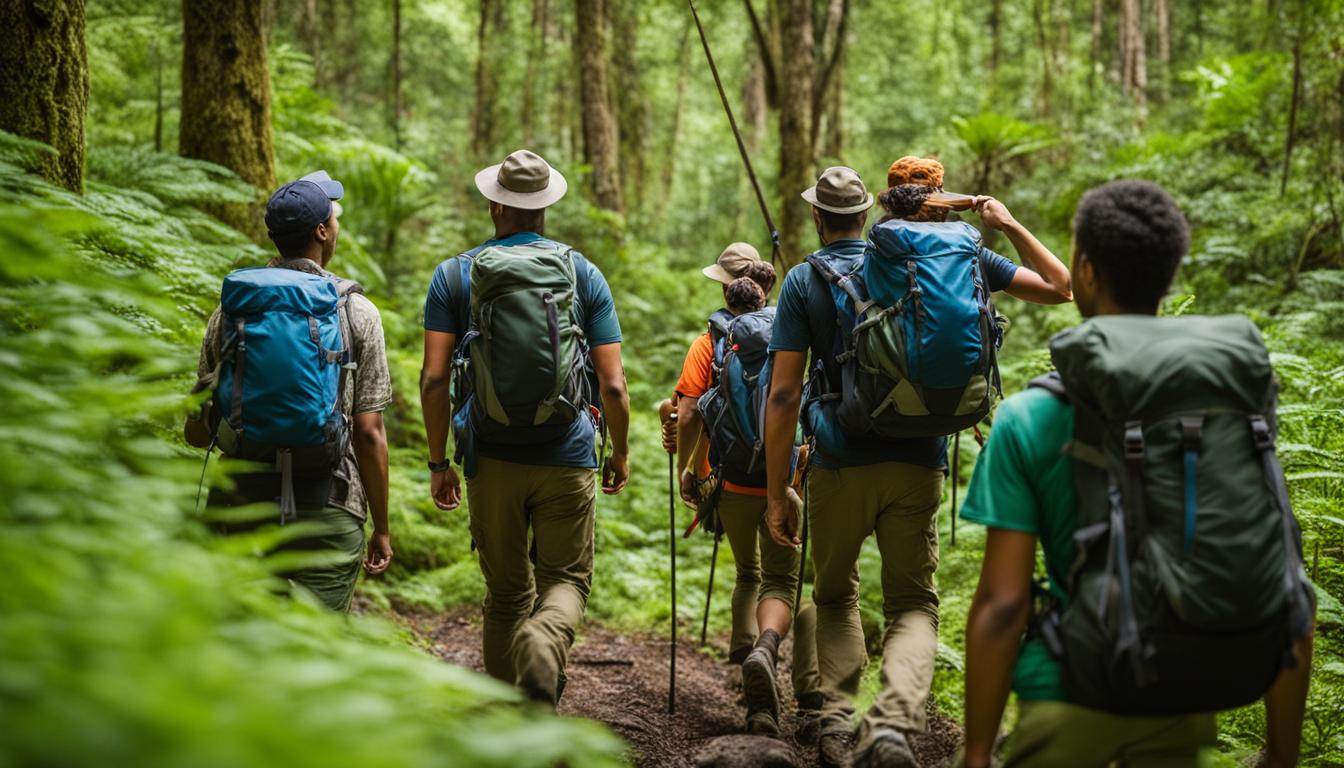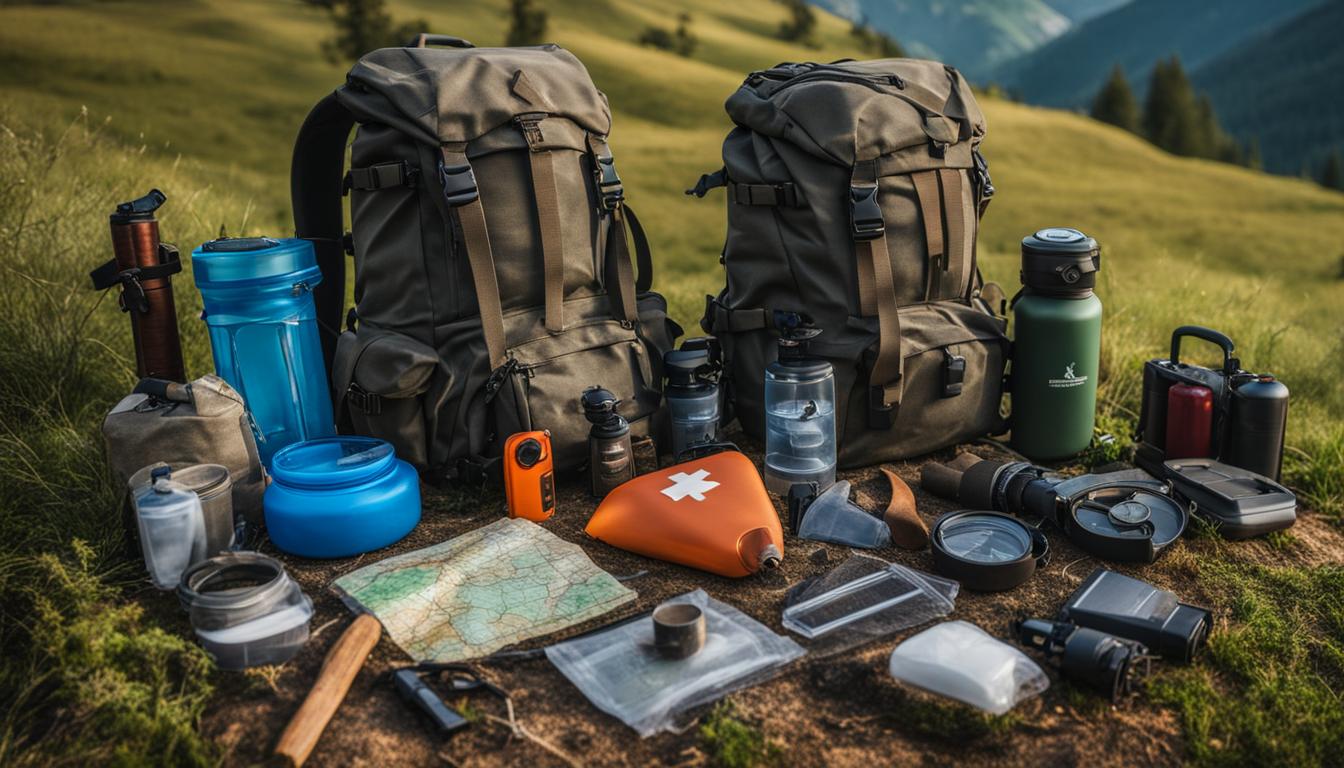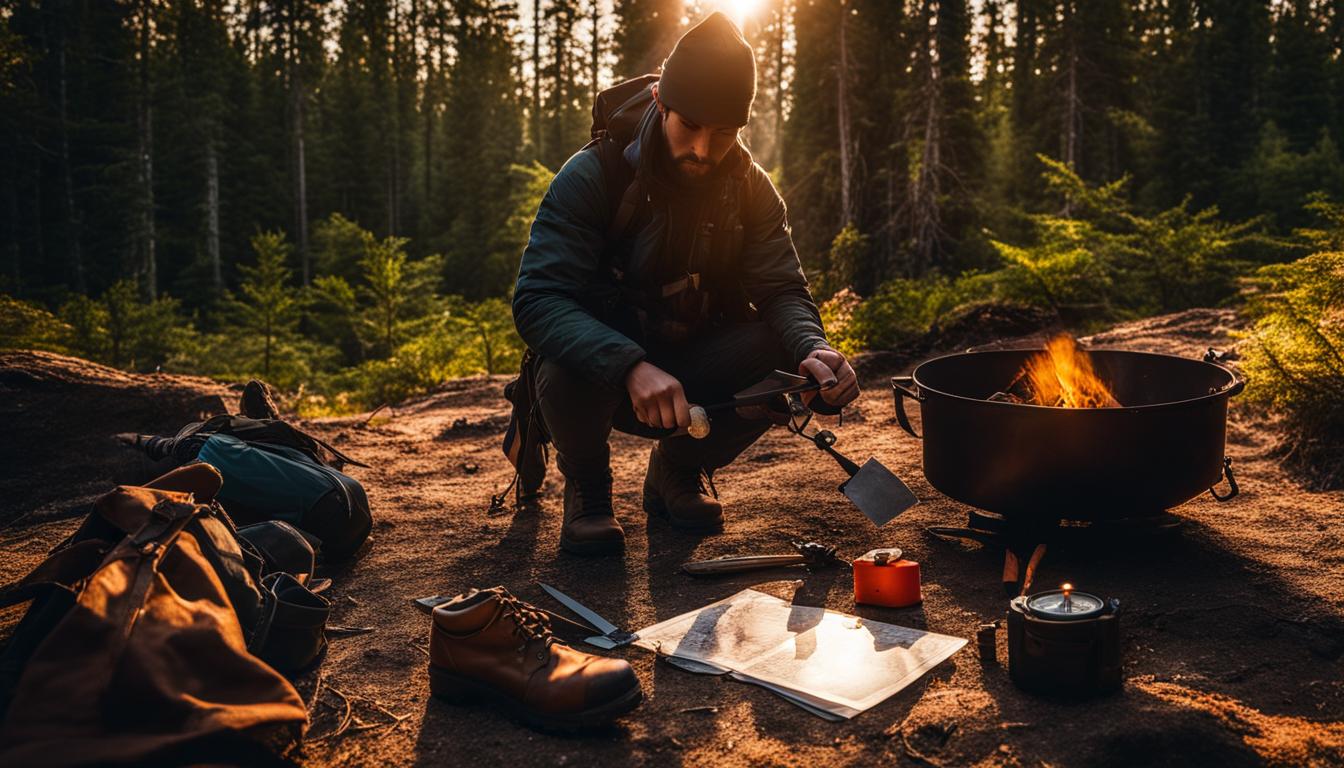Are you ready to take control of your survival in a SHTF situation? Knowing how to start and use a fire for survival is crucial, and it’s a skill every prepared person should have. As someone who has been through SHTF scenarios, I can confirm that mastering this key skill can make the difference between surviving or not in any emergency. So, if you’re committed to being prepared for any obstacle, continue reading!
In this article, I’ll be sharing my personal tips and tricks for starting and using a fire for survival. We’ll cover everything from gathering supplies to creating fuel sources, so by the end of it all, you’ll know exactly what it takes to build yourself a blazingly hot campfire – even in harsh conditions. Plus, we’ll add in some bonus advice on how to get creative with fire-building techniques so that you can truly feel liberated while surviving off the grid.
So don’t miss out on these essential lessons; they may give you the edge needed when SHTF. With me as your guide, let’s explore everything there is to know about starting and using fires for survival!
Definition Of SHTF
The term SHTF stands for ‘Shit Hits The Fan’. It’s a phrase used to describe a fast-changing, chaotic situation where everyday life as we know it has suddenly come to an end. It could be caused by natural disasters such as floods or earthquakes, economic collapse, civil unrest, war and other unforeseen events. In any case, the effects of SHTF can be devastating and long-lasting if you’re not prepared.
In order to survive during these times of extreme turbulence and instability, one must become self-reliant and resourceful in all aspects of their lives. This includes having access to essential survival gear that will help keep you safe while also making sure that your basic needs are met. Knowing how to start and use a fire is an important part of this preparation process. With the right knowledge and supplies at hand, you’ll be able to stay alive no matter what comes your way.
Having the ability to build and maintain fires when SHTF is incredibly important because it allows you to cook food, purify water, provide light and heat in cold temperatures, signal for help in an emergency situation, and much more. While many people think they already know how to make a fire from scratch, there are some key tips that everyone should know before attempting this task during challenging conditions. Moving on…
Essential Survival Gear
Starting a fire is essential for survival in many different SHTF scenarios. The ability to stay warm and cook food can give us an edge during times of desperation. That’s why having a few essential items on hand can make all the difference in the world when it comes to starting and maintaining a fire.
The first thing you’ll need is something called tinder, which is any material that will easily catch flame such as dry grass, wood shavings or leaves. You may also want to consider carrying some kindling like small pieces of bark or twigs so your fire will have fuel once you get it started. And don’t forget about matches or lighters – these are lifesavers if you find yourself without flint or another way to start a blaze!
Finally, you should always bring along at least one shelter item with you, just in case things go south quickly. This could be anything from a wool or synthetic fabric blanket to an emergency bivy sack – both of which provide warmth and protection against the elements while keeping your clothes dry and clean. With these items by your side, no matter what situation arises you’ll be prepared to create a lasting source of heat and light in order to keep yourself safe until help arrives.
Safety Tips For Starting A Fire
Starting a fire in an emergency situation can be a tricky task and needs to be done safely. I always remind myself of these three important guidelines when prepping for a fire: prepare the location, use proper materials, and keep safety in mind at all times.
When preparing the location, it’s essential to pick an area that is clear from any flammable items or hazardous material. You’ll also want to ensure that you’re not building your fire too close to anything combustible like trees or shrubs. Additionally, try to find an open space with enough room for air circulation so that your flames don’t spread out of control quickly.

Using the right kind of materials will help get your fire going faster and safer. Gather dry tinder such as small twigs and leaves along with larger pieces of wood like sticks and logs to feed the flames once they start growing. Make sure you have matches on hand or some other form of ignition source, but never use gasoline or kerosene; these substances are highly flammable and could cause serious harm if used incorrectly.
Finally, stay safe throughout this process by keeping children away from the burning embers until they’re extinguished completely. It’s also important to make sure there is a sufficient water supply nearby should things go south during your attempt at starting a fire. With just a few simple precautions, you can rest assured knowing that your efforts will pay off in the end! Now let’s move onto gathering and preparing fuel sources for our survival fire!
Gather And Prepare Fuel Sources
Now that you’ve chosen your spot, it’s time to gather and prepare fuel sources. Fuel is the key component in starting a fire and keeping it going, so this step should not be overlooked. To begin gathering fuel, look around for materials such as dried grasses, leaves, twigs, and even pine needles. These are all combustible substances which will help create an ember when ignited with a spark or flame source.

In addition to these natural materials found in your immediate area, also consider adding other items like paper products (such as newspaper), cardboard boxes, wood shavings from lumber piles or sawdust bags of kindling material typically used for camping trips. Here’s a markdown list of some common materials to collect:
- Natural Materials:
- Dried grasses
- Leaves
- Twigs
- Pine Needles
- Manmade Materials:
- Newspaper
- Cardboard boxes
- Wood shavings/sawdust
- Kindling material (typically used for camping)
Once you have gathered your supplies together properly into manageable pieces that can fit within your fire pit area, it’s time to start organizing them into layers and configurations that will allow oxygen flow through efficiently while still burning steadily. This could include anything from small stacks of larger logs arranged in alternating directions at the base of the pit up to smaller sticks laid over one another on top of those logs in crisscross patterns. With practice, building an efficient fire will become second nature!
Building Techniques For A Fire
Building a fire is one of the most important aspects of survival. You need to know how to construct a safe and effective fire if you want to survive in an austere environment. There are several techniques for building a fire, but it’s important that you understand the basics first before attempting any advanced methods.
The first step in constructing a successful fire is choosing the right location. Find an open area with plenty of room around your fire pit so that you can easily access wood and other supplies without putting yourself at risk from heat or smoke inhalation. Once you’ve chosen your spot, start gathering kindling – small twigs, dry leaves, and other combustible material – and arrange them in a tepee-like structure near the center of your pit.
Next, add larger pieces of wood such as logs or branches over the top of your kindling pile. Make sure there is enough air circulation between each piece so that they will ignite quickly when lit. For best results, use only seasoned (dried) hardwood like oak or hickory rather than green wood which takes longer to burn and produces more smoke. Finally, light the edges of your kindling pile using tinder or another type of igniting material such as matches or lighter fluid. Once ignited, adjust the size and shape of your flame by adding or removing fuel as necessary until it reaches its desired intensity level.
Now that you have successfully started your fire it’s time to learn about extinguishing and controlling it safely . Extinguishing and controlling a fire safely involves using the appropriate fire extinguisher or smothering the fire with dirt, sand, or a fire blanket. Additionally, you should always remember to wear protective gear, such as thick gloves and goggles, when attempting to extinguish a fire.
Extinguishing And Controlling The Fire
When it comes to dealing with fire, part of being a prepared survivor is understanding how to put out and control the flame. Having the ability to extinguish your fire in an expeditious manner can be lifesaving when SHTF.
The first thing you should remember is that if there’s no reason for keeping the fire going then don’t wait too long before putting it out. Being able to quickly smother or divert the oxygen supply away from your fire is paramount in some situations. Don’t forget about safety either; never leave a burning campfire unattended until you are certain all embers have been extinguished.
To ensure your fire has been doused, cover any remaining hot spots with dirt or sand – this will help prevent them from reigniting later on. Make sure that every spark has stopped smoking and all embers are completely cold before leaving the campsite – taking any necessary precautions as needed along the way!
With these tips in mind, you’ll be ready to control and manage fires while surviving during times of distress. Transitioning into using a fire safely in emergency scenarios requires keen knowledge, so stay tuned for subsequent section where we discuss how best to use a campfire in survival mode!
Uses Of Fire In An Emergency
Now that you know how to safely start, extinguish and control a fire for survival purposes, it is important to understand the many uses of fire in an emergency. Fire can be used to keep warm, cook food and signal for help. It also has psychological benefits as its warmth provides comfort during stressful times.
In a SHTF situation, having the ability to create a hot meal quickly will provide nourishment and reduce stress levels. You can use any type of fuel such as wood, twigs or dried leaves to build your Campfire Cooking Stove. This small stove allows you to boil water and prepare nutritious meals over a campfire with minimal effort.
Additionally, signaling fires are one of the most reliable methods of attracting attention when lost in the wilderness or trying to locate other survivors. A large bonfire placed on high ground is often visible from miles away at night making it perfect for calling out for help or finding companionship during difficult times.
Fire can bring us together even in the darkest hours by providing light and heat that offers both physical and mental relief from uncertainty and fear. With proper preparation and safety measures, using fire for survival should become second nature so if faced with disaster you can confidently make use of this invaluable resource! Having explored all the main ways fire can be useful in emergency situations, let’s now turn our attention towards cooking and heating with fire.
Cooking And Heating With Fire
I’m sure we all know how important fire is for survival in a SHTF situation. But it’s not just about starting a fire and keeping it going – you also have to be able to use the heat of that fire for cooking meals and heating your shelter. Let me share with you my tips for making the most out of your campfire!
| Advantages | Disadvantages |
|---|---|
| Versatile | Slow |
| Portable | Dangerous |
| Efficient | Unpredictable |
When it comes to cooking, I recommend bringing an array of tools like Dutch ovens, skillets, griddles, or even an open-flame grill. Each has its own advantages and disadvantages depending on what kind of food you’re cooking and where you are camping. For example, a skillet gives you more control over the temperature of your meal while giving off less smoke than other methods. Dutch ovens are great when baking because they retain heat better than any other tool. Open flame grills let you cook large amounts quickly but require careful monitoring as they can get hot very fast. Whichever method you choose, always remember that safety comes first! Have patience and practice common sense when working with open flames; never leave them unattended and keep combustible items away from the area at all times.
No matter where your travels take you during a SHTF scenario, having some way to cook your food will make life much easier. Fire offers so many opportunities to prepare tasty dishes while simultaneously providing warmth and comfort in harsh conditions. With these simple tips in mind, you’ll be ready to take full advantage of this incredible resource wherever your journey leads!
Signaling With Fire
The importance of being able to signal for help in an emergency situation cannot be underestimated. Fire can provide a powerful, visible way to call attention to your location and attract the attention of rescuers. With some knowledge and practice on how to effectively use fire as a signaling tool, you can increase your chances of surviving any type of disaster or SHTF event.
When it comes to using fire as sign language, there are several methods that work best. The most effective is smoke signals because they can often be seen from far distances. If possible, try to set up two large fires with plenty of fuel so that you can create thick plumes of smoke at regular intervals. You should also build them high enough above the ground so that their smoke rises higher into the air and is more easily seen by potential rescue teams or airplanes flying overhead. In addition, if you have access to bright colored materials like clothing or blankets, tie these items onto branches near one of the fires so they will catch the eye even better than just plain smoke.
Another great option for signaling is having a bonfire since this produces light which stands out in darkness much easier than normal flames do during daylight hours. Make sure you pay attention when building your bonfire – not only does it need lots of combustible material but make sure it’s placed somewhere where its light will stand out against surrounding terrain (like on top of a hill). Once lit, continuously monitor your bonfire so that it doesn’t get too big or spread beyond control! By following these tips and making sure you always carry necessary safety equipment such as matches and lighters, you’ll dramatically improve your chances for rescuing yourself successfully when stranded in an emergency situation caused by SHTF events.
Long-Term Fire Maintenance
We’ve discussed the basics of lighting and maintaining a fire. But what do you need to know if you want your fire to last for an extended period of time? In this section, I’ll discuss some important tips on how to keep your fire burning long-term when SHTF.
1) Start with plenty of fuel: To ensure that your fire lasts throughout the night, start off by adding a good amount of tinder and larger pieces of wood. Don’t go overboard as it can cause flames to become too large and difficult to control. Make sure there’s enough fuel for at least 4 hours – then add more once it starts getting low.
2) Monitor oxygen levels: Oxygen is essential for keeping any flame alive. Without enough oxygen, even the best fires will eventually die out. Keep an eye on wind direction and use small sticks or other debris to adjust air flow accordingly so that oxygen continues flowing into the center of your blaze.
3) Adjust size according to need: If you’re looking for just a small source of heat without creating a lot of smoke, ensure you don’t let the fire get too big; reduce its size by removing logs or breaking them down into smaller pieces if necessary. On the other hand, if you need more light or warmth than usual, increase the size of your fire by adding additional kindling or larger pieces of wood.
By following these simple steps, you should be able to maintain a strong and dependable campfire no matter what situation arises! Just remember that safety always comes first – never leave your fire unattended and always have a bucket full water nearby if things get out of hand.
Frequently Asked Questions
What Is The Best Type Of Wood To Use For A Fire?
Wood is a great source of fuel for any type of fire you’re trying to start. But not all types of wood are created equal when it comes to survival fires! Knowing which type of wood will give your fire the best chance at success is key. That’s why I’m here, to help you out and show you what kind of wood can make starting and maintaining a fire easier in an SHTF situation.
First off, let’s talk about tinder. This would be anything from dry grasses, small twigs and bark that catches easily on fire with just one spark or flame. You should always look for dead branches or sticks that have been drying outside – this makes them much easier to light than fresh, wet wood. If it’s raining hard enough, try using some cedar tree shavings as they catch flames even faster if dampened by rainwater. And if there isn’t any tinder around, don’t worry: use old cardboard boxes or newspaper instead!
Now once the tinder has caught flame, it’s time to add larger pieces of wood into the mix. The most important thing when selecting logs is picking ones that aren’t too big but also aren’t too small; having both sizes gives the fire better airflow and creates more heat (which means longer burning!). Hardwoods like oak and maple are usually good choices because they burn slowly and steadily over hours – perfect for cooking meals or keeping warm overnight! Soft woods like pine may work well in emergency situations since they tend to ignite quickly with little effort required from you.
No matter what type of wood you choose for your survival fire, making sure its dry and seasoned is essential for creating a successful blaze—so never underestimate the importance of gathering quality fuel before striking up a match!
What Is The Most Efficient Way To Build A Fire?
It’s estimated that up to 80% of all fire-related deaths are due to incorrect fire building techniques. Knowing how to build a fire efficiently is an essential skill for any SHTF survivalist. It can mean the difference between life and death in an emergency situation, so let’s take a closer look at the most efficient way to make one.
First, you’ll need some kindling material such as small twigs, thin tree bark strips, or even dry leaves. Place these materials on top of each other in a cross formation inside your campfire pit; then add larger pieces of wood like sticks and logs around them. The key here is to create an air gap between the fuel source and the flame – this will allow oxygen to reach the burning materials more easily which will help sustain your fire.
The next step is lighting the fire using either matches or a lighter. Make sure there’s plenty of airflow around your kindling pile before attempting to light it otherwise your efforts may be futile! Once lit, keep adding larger logs gradually until you have a steady flame going. This should provide enough heat for cooking food or keeping yourself warm throughout the night – both essential skills for surviving in harsh weather conditions during SHTF scenarios.
No matter what type of wood you use, following these simple steps will ensure you get maximum efficiency from your campfire without wasting too much time trying to get it started. With practice and experience comes mastery – eventually you’ll be able to quickly start fires with minimal fuss!
How Can I Use Fire As A Distress Signal?
Using fire as a distress signal has been an essential survival skill for centuries. In times of dire need, it’s one of the most reliable ways to get help when other methods have failed. As with any other SHTF survival tactic, there are some key points you should know about using fire as a distress signal in order to ensure your safety and increase your chances of being rescued. Here is a list of practical tips on how to use fire effectively:
- Choose the right location: Make sure you pick an open area that can be seen from far away such as hilltops or ridges so that potential rescuers will spot it sooner.
- Gather materials: Collect larger logs and fuel sources that burn longer and hotter. Also, make sure to prepare several piles of wood around the main flame source so that more smoke can be generated quickly if needed.
- Start a big blaze: A large fire will create much more smoke than a small one, making it easier for people to see from further away. To do this, stack up kindling in layers until all the pieces form into a tepee-like structure – this will provide plenty of oxygen for the flames to grow bigger and brighter.
- Signal regularly: Distress signals should be sent out continuously throughout the day in order for them to be noticed by passing aircrafts or boats – try sending three sets of smoke bursts every 15 minutes during daylight hours (if possible) and once per hour at night time (when visibility is lower). This way, potential rescuers won’t miss your call for help!
Making effective use of these simple tactics significantly increases your chances of being found faster by search parties or helicopters flying over head. Fire also provides additional benefits like keeping warm in cold environments and helping you cook food; both necessary components for staying alive in harsh conditions where resources are scarce. Just remember – practice makes perfect! With enough preparation, knowledge and experience you’ll be able to master even the toughest challenges associated with surviving off-the-grid scenarios like SHTF situations
What Should I Do If The Fire Gets Out Of Control?
If you find yourself in a situation where your fire gets out of control, it’s important to act quickly and decisively. The first thing you should do is assess the situation – look around and see what kind of resources are available that can help contain or extinguish the flames. If there’s plenty of water nearby, use buckets or other containers to pour it over the fire until it’s extinguished. Or if there’s sand nearby, you can create a barrier by piling up sand between the fire source and any combustible material like brush or leaves.
You also need to be aware of how quickly wind can spread a fire, so don’t hesitate to relocate if necessary (but make sure your new spot isn’t vulnerable to an uncontrolled blaze). It may be tempting to try and move large logs away from the fire with bare hands, but this will only increase its intensity – instead use sticks or branches as leverage. And remember: safety comes first! Don’t risk getting hurt trying to put out a wildfire; better leave it for professionals who know their way around these kinds of situations.
In some cases, such as when camping outdoors, you might want to set off a distress signal using your blazing inferno – just make sure not to compromise your own safety while doing so. Always have at least two exits planned before setting one off – ideally one on each side of the campfire – and keep them clear of obstacles at all times. That way, no matter which direction the wind takes the flame, you’ll always have a safe escape route ready. Make sure everyone within range knows about it too; otherwise they won’t realize they’re in danger until it’s too late.
How Can I Make Sure The Fire Will Last For A Long Time?
When it comes to using a fire as part of your shtf survival strategy, one of the most important things you need to know is how to make sure it will last for a long time. Whether you’re in an emergency situation or simply camping outdoors, having a reliable source of heat can be essential.
There are several tactics that can help you get more out of your fire, and many of them require minimal effort. For example:
- Gather Dry Wood: Always use wood that is dry and well seasoned – if possible, find wood with low moisture content (under 20%). If the wood is too wet, it won’t burn as efficiently and may put off excessive amounts of smoke.
- Make sure there’s plenty of tinder and kindling on hand so that getting the fire started doesn’t take too much effort.
- Don’t forget about larger pieces of fuelwood; these should be arranged into a loose stack around the edge of the fire pit so they’ll catch quickly when ignited.
- Stack Logs Properly: The key here is to create an efficient structure that will allow air to reach all parts of the fire easily. Place logs perpendicular to each other in alternating layers like bricks in a wall and leave space between them for airflow.
- Keep Fire Small: A small but intense flame uses less fuel than a large slow burning one, so don’t feed too much material into your fire at once unless absolutely necessary. Use only what you need for cooking or warmth and let everything else wait until later.
Finally, remember that tending your fire can also extend its life by keeping oxygen flowing through it properly while reducing sparks which could start unwanted fires nearby! With proper preparation and maintenance, you can keep your campfire going strong throughout any adventure or emergency situation.
Can Foraging and Hunting for Food Help in a Survival Situation?
In a survival situation, relying on foraging and hunting for food can be crucial. These skills allow individuals to harness the natural resources around them for sustenance. Foraging involves gathering edible plants and fruits, while hunting involves catching animals for meat. Masters of foraging and hunting for food can maximize their chances of survival in challenging environments.
Conclusion
The power of a fire should never be underestimated in any SHTF situation. It can provide life-saving warmth, light up the darkness and cook food when you need it most. But to get the most out of your fire, you must know what type of wood to use, how to build it efficiently and safely, and how to make sure that it lasts as long as possible.
By learning these important lessons now, you’ll be better prepared for whatever comes your way during an emergency or disaster scenario. And with practice comes confidence – so don’t forget; everytime you light a campfire for fun or survival purposes take note of what works best for you and keep honing those skills!
Finally, remember: A good fire is one of the greatest gifts nature has given us – use it wisely and always respect its potential danger. With careful preparation and knowledge come great rewards – may this guide help equip you with the tools necessary to stay safe and warm no matter what Mother Nature throws at you!



















